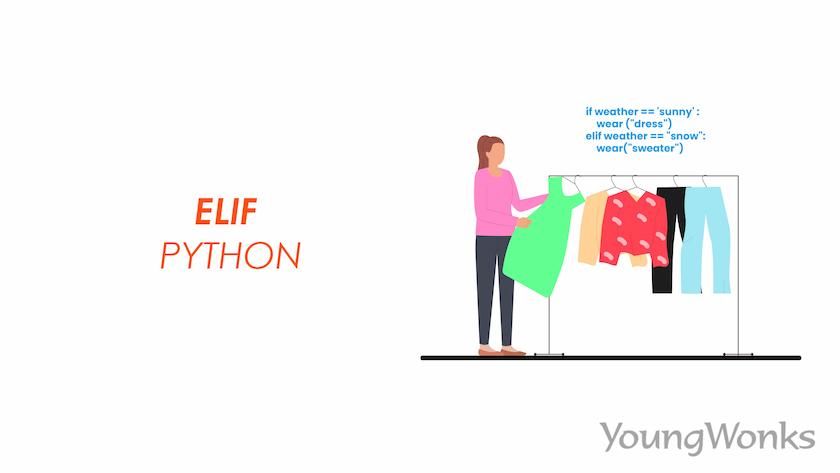Mar 11, 2024 By Team YoungWonks *
Starting with syntax, we will break down the structure of 'elif' statements, dissecting each component to illuminate its role in the decision-making process. Moving forward, we'll delve into real-world examples and scenarios where 'elif' statements shine, illustrating how they contribute to code organization and overall program efficiency.
Through this tutorial, our goal is to empower you with a detailed understanding of 'elif' statements, equipping you to leverage this feature confidently in your Python projects. By exploring diverse examples and scenarios, we aim to solidify your comprehension and enable you to apply 'elif' statements effectively in your own coding endeavors.
Conditional Statements in Python
Conditional statements form the cornerstone of programming, allowing the execution of specific code blocks based on predefined conditions. These structures introduce flexibility and responsiveness to a program's logic, enabling dynamic adaptation to diverse situations. In Python, the 'if-elif-else' structure is fundamental for effective decision-making in the language's control flow.
The 'if' statement serves as the initial checkpoint, evaluating a condition to determine the execution of a specific code block. Subsequently, the 'elif' statement, a concise 'else if,' facilitates the sequential consideration of multiple conditions. This structured approach proves invaluable for handling diverse scenarios encountered during program execution.
The versatility of the 'if-elif-else' structure is evident as we explore its syntax and practical applications. A comprehension of how these statements work together is crucial, particularly for beginners in a Python tutorial. This knowledge empowers them to craft logic that dynamically responds to changing conditions, enhancing the adaptability and robustness of their Python code.
In essence, mastery of conditional statements, including 'if-elif-else,' is pivotal for beginners in a Python tutorial. This skill equips them to navigate different paths based on specific criteria, setting the foundation for constructing sophisticated and responsive applications. Throughout the learning journey, it's essential to familiarize oneself with keywords such as 'elif condition,' 'pass statement,' 'else block,' and 'else conditional.'
Additionally, understanding concepts like 'while loop,' 'tuples,' 'print statement,' 'lambda,' and 'case statement' contributes to a holistic comprehension of Python's conditional and control flow structures. Exploring practical examples involving 'sql,' 'excel,' and 'python lists' enhances real-world application understanding.
Syntax and Indentation
The syntax of the 'elif' statement is straightforward:
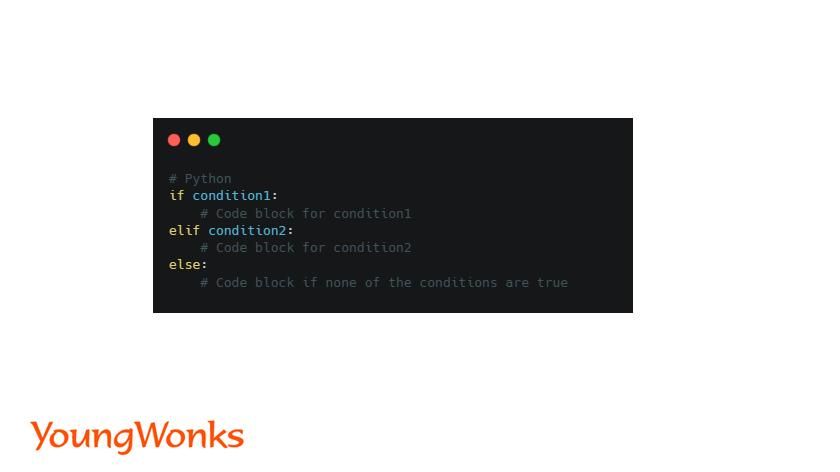
Indentation determines the scope of a code block. Unlike languages like Java or C, Python relies on proper indentation for code structure.
Elif Statements in Action
Let's illustrate the use of 'elif' with a simple example:
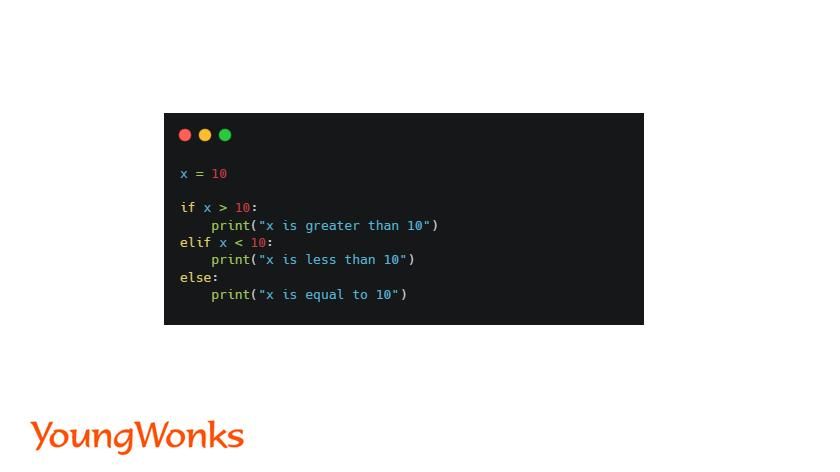
In this scenario, the 'elif' statement allows us to specify an alternative condition if the initial 'if' condition is false. This flexibility is crucial in decision-making within a program. This Python code evaluates the value of the variable 'x,' which is initialized to 10. The 'if' statement checks if 'x' is greater than 10, and if true, it prints "x is greater than 10." If the 'if' condition is not met, the 'elif' (else if) statement is evaluated, checking if 'x' is less than 10. If this condition is true, it prints "x is less than 10." In the scenario where neither the 'if' nor 'elif' conditions are satisfied, the 'else' statement is executed, printing "x is equal to 10." Therefore, the code systematically determines the relationship between the variable 'x' and the value 10, providing a clear and concise output based on the specified conditions.
Boolean Logic and Logical Operators
Understanding Boolean values and logical operators is pivotal when working with 'elif' statements. 'True' and 'False' are the Boolean values, and logical operators such as 'and,' 'or,' and 'not' help in creating complex conditions.
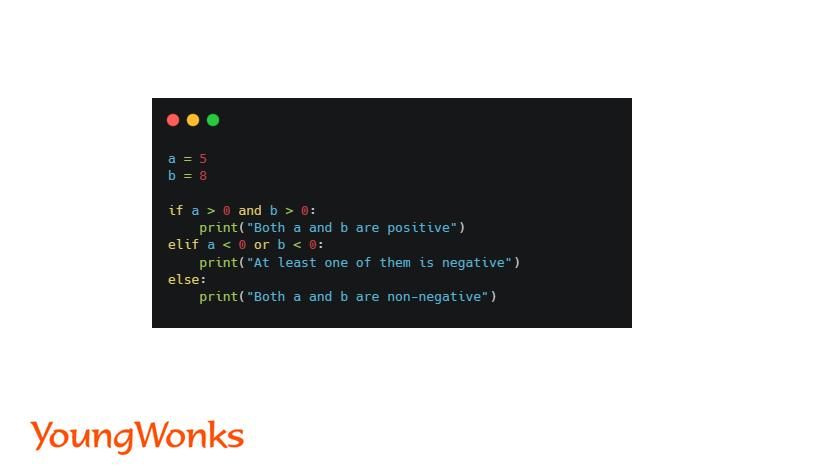
In this Python code snippet, two variables 'a' and 'b' are assigned values, with 'a' set to 5 and 'b' to 8. The 'if' statement checks whether both 'a' and 'b' are positive by using the logical 'and' operator. If this condition is true, it prints "Both a and b are positive." If the 'if' condition is not met, the 'elif' (else if) statement is evaluated. This time, it checks whether at least one of the variables is negative, utilizing the logical 'or' operator. If this condition is true, it prints "At least one of them is negative." In the event that neither the 'if' nor 'elif' conditions are satisfied, the 'else' statement is executed, printing "Both a and b are non-negative." Thus, the code systematically determines the positivity or negativity of both 'a' and 'b' and provides a corresponding output based on the specified conditions.
Elif-Else Statement
The 'elif' statement can be followed by an 'else' clause, allowing for a default action when none of the specified conditions are met. The 'elif' statement in Python exhibits added flexibility when complemented by an 'else' clause, providing a mechanism for incorporating a default action when none of the preceding conditions are met. This combination enhances the decision-making capabilities of the code, ensuring that there is a designated course of action, even if none of the specified conditions within the 'elif' statements are satisfied. This feature is particularly valuable in scenarios where a fallback or default behavior is essential, adding an additional layer of robustness and completeness to the conditional logic employed in Python programming.
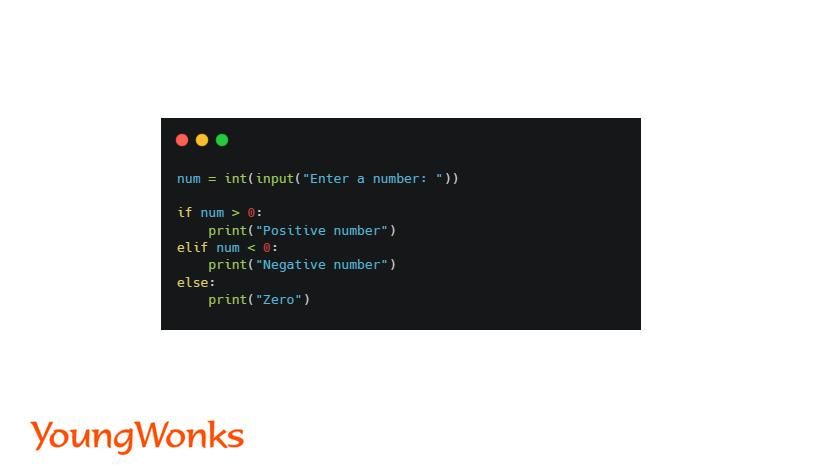
In this example, user input is used to showcase the 'elif-else' structure, creating a dynamic and interactive program.
Decision Making and Control Flow
Decision-making in programming often relies on the versatility of the 'elif' statement, a crucial element in various scenarios involving control flow. Its significance extends beyond simple conditions, finding utility in complex situations, especially within iterative processes like loops and data manipulation, where decision paths may be necessary for efficient and effective program execution.
The 'elif' statement becomes an indispensable tool when dealing with multiple conditions, allowing programmers to create logical structures that respond dynamically to changing situations. In the context of loops, this statement empowers developers to introduce conditional checks at each iteration, steering the program in different directions based on evolving data or user input.
Moreover, in the realm of data manipulation, the 'elif' statement proves valuable in constructing decision trees that guide the transformation or analysis of data based on various criteria. This adaptability enhances the overall control flow of the program, contributing to its resilience and ability to handle diverse datasets or user interactions.
Understanding the applications of the 'elif' statement becomes particularly beneficial as programmer’s advance in their coding proficiency. It not only streamlines decision-making but also fosters code readability and maintainability, crucial aspects of producing high-quality and sustainable software solutions. In essence, the 'elif' statement is a versatile tool that significantly contributes to the precision and efficiency of decision-making within the broader spectrum of programming tasks.

This example demonstrates how 'elif' statements can be used to categorize grades in a simplistic grading system. This Python code utilizes a 'for' loop to iterate over a list of grades, where each grade is evaluated against a set of conditions within 'if-elif-else' statements. For each grade, the code checks progressively stricter conditions, starting with whether the grade is greater than or equal to 90, in which case it prints "A." If this condition is not met, it moves to the 'elif' statement checking if the grade is greater than or equal to 80, and if true, it prints "B." The process continues with 'elif' conditions for grades greater than or equal to 70 for a "C" grade. If none of these conditions are satisfied, the 'else' statement is executed, printing "F" to indicate a failing grade. In summary, the code classifies each grade in the list into letter grades based on the specified criteria, providing a clear and concise representation of academic performance.
Advanced Usage and Nesting
In more intricate programming scenarios, the advanced usage of 'elif' statements involves nesting them to create sophisticated decision trees. This nesting capability allows programmers to handle complex conditions and guide the program through a series of choices. However, it is essential to exercise caution and balance in the application of nested 'elif' statements to ensure both readability and maintainability of the code. Nested 'elif' statements are particularly useful when dealing with multifaceted decision-making requirements, where various conditions need to be considered within specific contexts. This advanced usage enables the creation of intricate logical structures, ensuring that the program responds appropriately to diverse scenarios.
While nesting 'elif' statements enhances the expressive power of the code, developers must be mindful of the potential pitfalls associated with excessive nesting. Excessive nesting can lead to code complexity, making it harder to understand, troubleshoot, and maintain. Striking a balance between achieving the desired functionality and keeping the codebase clean and comprehensible is crucial for long-term code sustainability. The advanced usage of nested 'elif' statements provides a powerful mechanism for handling complex decision trees in programming. However, practitioners must be diligent in maintaining readability and avoiding excessive nesting to ensure that the code remains clear, concise, and manageable, even as the complexity of decision-making logic increases.
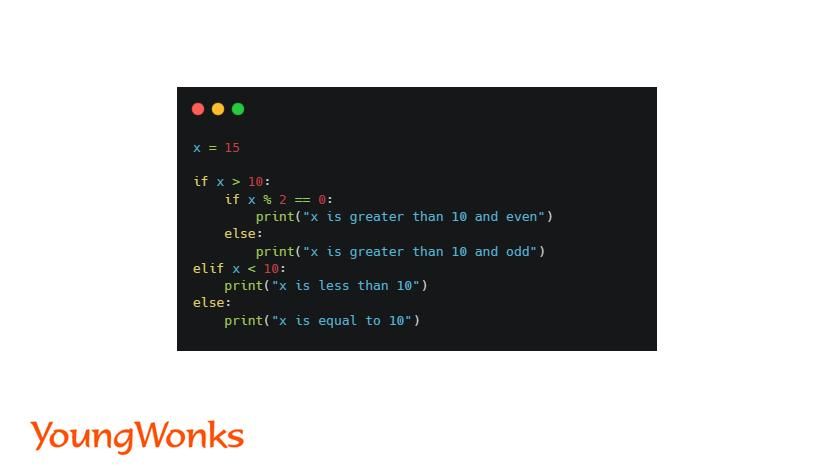
This Python code demonstrates nested conditional statements to evaluate the value of the variable 'x.' The outer 'if' statement checks if 'x' is greater than 10, initiating a nested 'if-else' block. Within this block, the inner 'if' statement examines whether 'x' is even or odd using the modulo operator. If 'x' is greater than 10 and even, it prints "x is greater than 10 and even"; otherwise, it prints "x is greater than 10 and odd." If the outer 'if' condition is not met, the 'elif' statement checks if 'x' is less than 10, printing "x is less than 10" if true. Finally, if neither the 'if' nor 'elif' conditions are satisfied, the 'else' statement is executed, printing "x is equal to 10." This nested structure allows for a detailed and hierarchical assessment of 'x' based on multiple conditions, providing output depending on its value.
Elif in Comparison with Other Languages
The 'elif' statement in Python bears a similarity to the 'else if' statement present in languages such as JavaScript and Java. While they share a common purpose in facilitating multi-branch decision-making, it is essential to recognize the differences in syntax and behavior when transitioning between these programming languages.
In JavaScript, for instance, the 'else if' statement serves a parallel role to Python's 'elif,' allowing developers to evaluate multiple conditions sequentially. However, syntactical disparities exist, and awareness of these distinctions is vital for programmers navigating across these languages. Likewise, in Java, the 'else if' construct is used for handling multiple conditional cases, but the syntax varies compared to Python's 'elif' statement.
By comprehending the similarities and differences between 'elif' in Python, 'else if' in JavaScript, and the equivalent constructs in other languages, programmers can smoothly transition between diverse coding environments. This cross-language awareness enhances adaptability and fosters a deeper understanding of programming concepts, contributing to a more versatile skill set for developers working across various technological landscapes.

Elif in Python Functions
'Elif' statements play a pivotal role in enhancing the functionality of Python functions, offering a means to create robust and dynamic behavior tailored to specific requirements. Within functions, the strategic integration of 'elif' allows developers to define and modify parameters and conditions, enabling the adaptation of the function's behavior based on changing input or contextual factors. This versatility ensures that functions can address a variety of scenarios, making them powerful tools for developers seeking to create modular and flexible code. Whether handling diverse data types, user inputs, or external conditions, the judicious use of 'elif' statements within Python functions contributes to the creation of code that is not only efficient but also adaptable to a wide range of use cases.
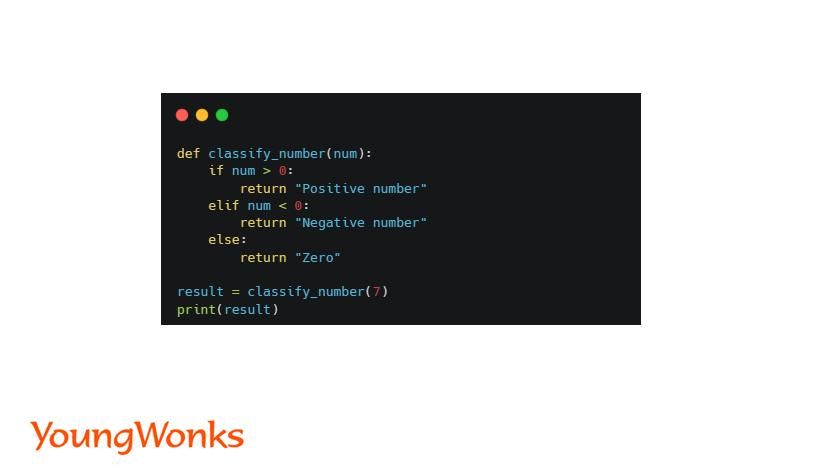
Real-world Applications: Machine Learning, Data Science, and More
In the expansive domains of machine learning and data science, 'elif' statements emerge as indispensable tools in decision-making processes, facilitating the implementation of sophisticated logic. Whether it involves classifying data, constructing models, or managing user input, the capability to make informed decisions based on specific conditions is paramount for achieving accurate and efficient outcomes.
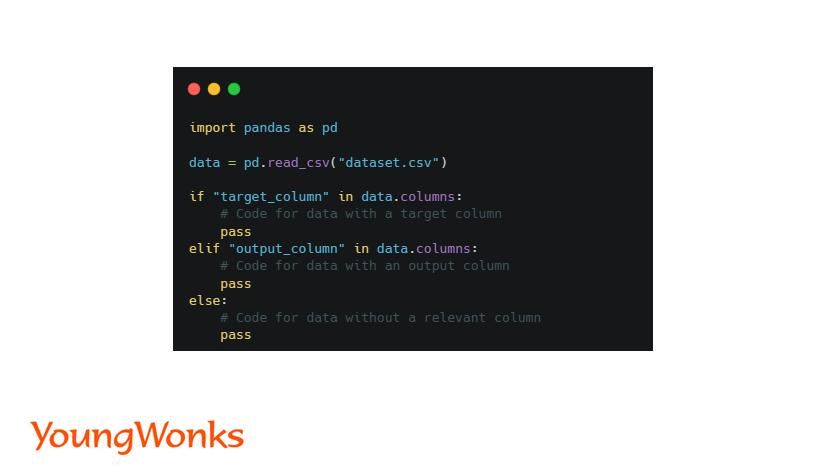
The provided Python code snippet exemplifies the practical application of 'elif' statements within the context of data processing. Using the Pandas library to read a dataset, the code checks for the existence of crucial columns like "target column" and "output column." The 'elif' statements enable the program to branch into distinct code blocks based on the presence or absence of these columns, allowing for tailored processing depending on the nature of the data. This type of conditional logic is crucial in real-world scenarios where datasets may vary, ensuring that the code adapts dynamically to diverse data structures and requirements.
In essence, the strategic use of 'elif' statements in machine learning and data science not only enhances the adaptability of algorithms but also contributes to the creation of robust and flexible data processing pipelines. As these fields continue to evolve, the role of 'elif' statements in decision-making processes remains pivotal for developing intelligent and responsive solutions that cater to the intricacies of diverse datasets and analytical tasks.
Conclusion
In conclusion, 'elif' statements stand as a vital and versatile component within Python's suite of conditional statements, providing programmers with the means to craft code that is not only flexible but also responsive to varying conditions. Achieving mastery in the use of 'elif' statements is paramount for honing skills in effective decision-making, steering control flow, and constructing dynamic programs capable of adapting to diverse scenarios. This proficiency proves invaluable for both beginners and experienced programmers alike, as understanding of 'elif' empowers them to design more intricate and efficient code structures.
In practical terms, 'elif' statements facilitate the seamless transition between different branches of code, allowing you to handle diverse scenarios effectively. Whether it's the first condition in a series or a subsequent block of code, the judicious use of 'elif' ensures that your program responds intelligently to the conditions it encounters, providing a solid foundation for the development of efficient and adaptive Python applications.
As you navigate through your journey into the world of Python, it's essential to recognize and harness the power that 'elif' brings to your code. The ability to employ 'elif' statements with finesse not only streamlines your programming workflow but also enhances the readability and maintainability of your codebase. Whether handling conditional logic, creating advanced algorithms, or contributing to machine learning projects, the versatility of 'elif' remains a fundamental asset in building robust and responsive Python programs. Thus, embracing and mastering 'elif' contributes significantly to your overall proficiency and creativity as a Python programmer.
Enhance Your Child's Programming Skills with YoungWonks
In Coding Classes for Kids at YoungWonks, we believe in nurturing young minds through comprehensive and engaging curriculum. Our Python Coding Classes for Kids are designed to introduce students to the world of programming in a fun and interactive way. By emphasizing the concepts of ELIF in Python, we aim to build a strong foundation that enables students to tackle more complex coding challenges in the future. Beyond Python, for those interested in expanding their knowledge to hardware programming and game development, our Raspberry Pi, Arduino, and Game Development Coding Classes offer a unique opportunity to explore and innovate. Join us at YoungWonks and take the first step towards becoming a proficient programmer.
*Contributors: Written by Disha N; Edited by Rohit Budania; Lead image by Shivendra Singh
